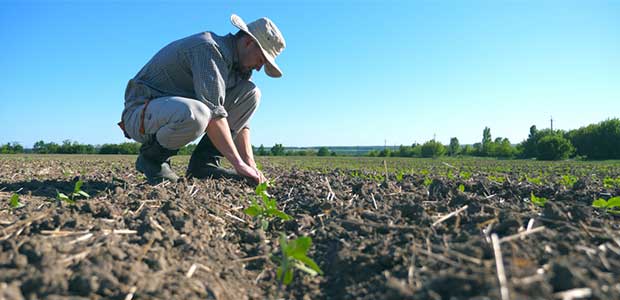
It’s a Hot 80-Degree Day: Has Your Lone Worker Checked In?
Summer heat will affect everyone, but it will be particularly hard on those working in agriculture, spending long hours outside in the blistering temperatures.
- By Gen Handley
- Jun 22, 2020
On June 20, 2020, the sun reached its highest point in the sky, marking the first day of summer. For the next few months, most of the US will be seeing more daylight and warmer, even scorching, temperatures. This heat will affect everyone, but it will be particularly hard on those working in agriculture, spending long hours outside in the blistering temperatures.
When a worker is exposed to extreme heat, their body temperature rises quickly, and they can experience heat illness which includes a number of debilitating symptoms such as muscle cramping, fatigue, headache, nausea or dizziness. They can also experience dehydration and fainting which can lead to horrible errors operating machinery or to a crippling if not deadly fall, a common cause of injuries for agricultural workers. But on top of that, these workers who help feed people in this country and around the world are exposed to hazardous chemicals, such as pesticides and cleaning agents.
Despite the multitude of safety risks that these workers face every day, there are proactive steps that can be taken to protect these people so that they can go home safely to their families at the end of the day.
Deadly Falls
Falls are one of the most common causes for injury and death in agriculture. Falls usually occur off ladders, farm machinery, trucks and roofs. You can prevent falls by:
- Using safety harnesses when working from dangerous heights
- Installing good lighting where falls might occur
- Using non-slip tape and matting where workers frequent
- Attaching grab rails on ramps, steps, ladders, trucks and machinery
- Equipping your workers with well-fitting footwear that have non-slip soles
- Providing an automated fall-detection device due to exhaustion or dehydration
Heat Exhaustion and Dehydration
During the hot summer months, heat exhaustion and dehydration in agriculture workers is very prevalent. For example, the State of California states that workers “shall be allowed and encouraged to take a preventative cool-down rest in the shade when they feel the need to do so to protect themselves from overheating.” It is also recommended that adult males drink at least 3.7 liters (125 ounces) of fluid a day and adult females drink 2.7 liters (91 ounces) a day. Dehydration can be prevented by:
- Providing water to hydrate before a worker’s shift
- Providing regularly replenished, potable water stations throughout the work areas (Workers must have the opportunity to drink one cup of water every 15 to 20 minutes)
- Providing light-colored or reflective, breathable and loose-fitting work clothing
- Providing headwear that keeps direct sunlight away from the head and face
- Planning regular breaks for workers in shaded or air-conditioned areas
- Scheduling heavy work that requires personal protective equipment later in the day
- Providing dependable emergency communications for the workers in case they are not feeling well
Hazardous Chemicals
Agriculture workers are exposed to a number of potentially hazardous chemicals such as pesticides, ammonia and sanitizers, and they can easily inhale and absorb them through their skin. To mitigate this hazard, consider using non-toxic options whenever possible. When this is not an option, to protect your workers, you must provide personal protective equipment (PPE) such as glasses, face masks, boots, gloves and respirators. Your team must be properly trained and educated about how to use hazardous chemicals.
Additionally, like water stations to hydrate your workers, you must have first aid stations with clean water to flush out the chemical after the person has come into contact with it. The California Department of Pesticide Regulation states that lone agriculture workers must check in every hour and be in communication with a responsible adult when handling pesticides. This can be done via personal, radio, telephone or automated system contact.
Hazardous Machinery
When it comes to preventing injuries from farm equipment, the most important step you can take is to thoroughly train your workers on how to use this machinery. You must emphasize thoughtful operation of the machinery and encourage workers not to rush during use. The said machinery must be properly and regularly maintained, and any repairs must be promptly made. Like working with hazardous chemicals, you must provide your workers with proper PPE and not allow loose clothing that can become entangled in moving parts.
Proactive Measures
To prevent one of these incidents from even occurring, it is beneficial to build a build positive safety culture within your agriculture operations. A proactive strategy to protecting your workers will not only minimize your risk but will help you be ready when an accident does happen. The first step in creating a strong culture of safety is identifying the hazards in the workplace, minimizing the chance of an accident or injury occurring.
Address and Implement
Once you’ve identified the hazards on your agricultural operation, you then need to address them and implement the necessary steps to mitigate the risks and protect your workers out in the field. Not only is the wellbeing of your valued workers at stake, but so is your business and operations. The hazards of farm operations may vary, but no matter what, you need to exhaustively assess all of the risks facing your workers, explore ways to quell these risks and then implement them as soon as possible—your team, their families and your business will thank you.